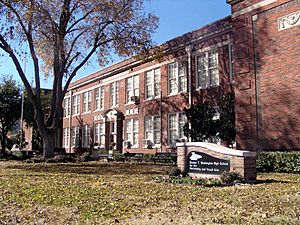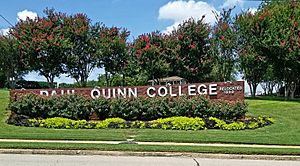History of African Americans in Dallas–Fort Worth facts for kids
The Dallas–Fort Worth metroplex is home to about 1.2 million African Americans. This makes it the second-largest population of African Americans in Texas. In 2007, Black Enterprise magazine even named Dallas one of the "Top 10 cities for African Americans."
Contents
History of African Americans in Dallas-Fort Worth
Early Days and Growth
Freedmen’s Cemetery was started in 1861. It was a burial ground for formerly enslaved people. In 1953, the Hamilton Park neighborhood became one of the first suburbs in Texas built specifically for African Americans. By the late 1800s, more than 11,000 black people lived in Dallas.
Changes and Progress
In the 1990s, many African Americans in Dallas saw their incomes grow significantly. Around 2005, more and more African Americans began moving to suburban areas north of the city.
In 1995, Dallas made history by electing its first black mayor, Ron Kirk. Later, in 2019, Eric Johnson became the city's second black mayor.
Between 2010 and 2020, the Dallas–Fort Worth area welcomed about 259,000 new African Americans. This was a nearly 27% increase! The Brookings Institution reported that from 2006 to 2010, Dallas-Fort Worth had one of the highest numbers of black people moving into the area in the entire U.S. Many African Americans have moved to the metroplex since 2010 because of its affordable cost of living and good job opportunities.
Where African Americans Live in Dallas-Fort Worth
Changing Neighborhoods
In 1850, Dallas County had at least 207 black residents. This was less than 10% of the county's total population. For a long time, most black communities were in the central parts of Dallas and Fort Worth. However, this started to change in the 1980s.
Growth in Suburbs
Since the 1990s, the black population in the northern suburbs has grown by 178%. The biggest growth has been in the southern suburbs. For example, Cedar Hill was about 51.9% black in 2010. This was after more than 12,500 new black residents moved there since 2000.
The southern suburbs, like DeSoto, Duncanville, Lancaster, and Cedar Hill, are known as key areas for the African-American middle and upper-middle class in the metroplex. Stop Six is also a historically black neighborhood in Fort Worth.
In 2005, Mansfield had 62 African-American households earning at least $100,000 a year. In Rowlett, the average income for African-American households was even higher than the city's overall average income that same year.
Politics and Business
Mayors and Chambers of Commerce
As mentioned, Ron Kirk was Dallas's first black mayor, serving from 1995 to 2002. Eric Johnson became the second black mayor in 2019.
The Black Chamber of Commerce in Dallas was started in 1926. It is the oldest black chamber of commerce in the United States! Fort Worth and some nearby cities also have their own black chambers of commerce. These groups help support black-owned businesses.
Media and News
Publications for the Community
The Dallas Weekly is the largest newspaper for African Americans in the Dallas-Fort Worth area. The Dallas Examiner is another widely read publication.
Other black newspapers in the region include the Dallas edition of African-American News and Issues, Black Economic Times, Community Quest, The Dallas Post Tribune, LaVita News/The Black Voice (in Arlington), Minority Business News, and Minority Opportunity News Gazette. The Dallas Express was an important newspaper published in the city from 1892 to 1970.
Education
Schools in the Past and Present
Schools During Segregation
Before schools were integrated (when students of all races could attend together), the Dallas Independent School District had several high schools just for black students. These included Booker T. Washington, Lincoln, and James Madison. Other schools for black children were George Washington Carver Elementary, Benjamin Franklin Darrell Elementary, Frederick Douglass Elementary, Eagle Ford Elementary, Joseph J. Rhoads Elementary, H.S. Thompson Elementary, Phyllis Wheatley Elementary, and Colonial School.
The first high school for black children was called 9th Ward School. Its name changed to Dallas Colored High School in 1893. In 1927, that building became B.F. Darrell Elementary School. Booker T. Washington High School opened in 1922. Lincoln High School, the second black high school, opened in 1939.
The Catholic church also ran St. Peter's Academy for black children in Dallas. In the Carrollton-Farmers Branch Independent School District, the Carrollton Colored School served black children during this time.
Schools Today
Around 2005, more African-American students started attending schools in the Best Southwest area. Many wealthier African-American parents moved to different school districts. They believed these districts offered better education for their children. Some also chose to send their children to private schools. In 2001, about 5,400 black students in the region attended private schools.
From 2000 to 2010, the number of black students in Dallas ISD went down by 20,000. This was the lowest number since 1965. One reason for this change is that many black families moved to the suburbs. They often felt that suburban public schools were better than those in Dallas ISD. They also looked for better housing and safer neighborhoods. Another reason was the growth of charter schools. These schools attracted students who might have otherwise gone to Dallas ISD schools.
Colleges and Universities
Paul Quinn College is the only HBCU (Historically Black College and University) in the Dallas–Fort Worth metroplex.
In 1961, Bishop College, another black college, moved to Dallas from Marshall, Texas. It closed in 1988. In the late 1940s, Texas Vocational School offered special training courses for black World War II veterans.
The University of Texas at Arlington gives out the most bachelor's and master's degrees to African Americans in Texas.
Fun and Culture
Events and Attractions
The DFW metroplex hosts one of the largest HBCU football events in the country, the State Fair Classic.
Dallas Black Restaurant Week is an event that promotes and celebrates black-owned restaurants and chefs in the area. Dallas Black Pride is the biggest celebration for the black LGBT community in Texas.
There are many interesting places to visit that highlight African-American culture. These include the African-American Museum of Dallas in Fair Park, the Dallas Black Dance Theatre, and The Black Academy of Arts and Letters, both in downtown. The South Dallas Cultural Center focuses on supporting black artists in performing, writing, and visual arts.
In Fort Worth, you can visit The Lenora Roll Heritage Center Museum and the National Multicultural Western Heritage Museum. These museums share the history of African-American culture, especially in North Texas. In Irving, the Jackie Townsell Bear Creek Heritage Center tells the story of Bear Creek of West Irving, one of the oldest black communities in North Texas.
Notable People
Many famous African Americans have connections to the Dallas-Fort Worth area:
- Erykah Badu - R&B and soul artist
- Chris Bosh - former NBA player
- Juanita Craft - civil rights activist and politician
- Kirk Franklin - gospel singer
- Bishop T.D. Jakes - gospel preacher
- Eric Johnson - Mayor of Dallas
- Jill Marie Jones - actress
- Ron Kirk - former Mayor of Dallas
- David Mann - actor and singer
- Tamela Mann - actress and singer
- Deion Sanders - TV personality and former NFL player
- A. Maceo Smith - civil rights activist
- Emmitt Smith - TV personality and former NFL player
- Spinderella - hip-hop DJ



